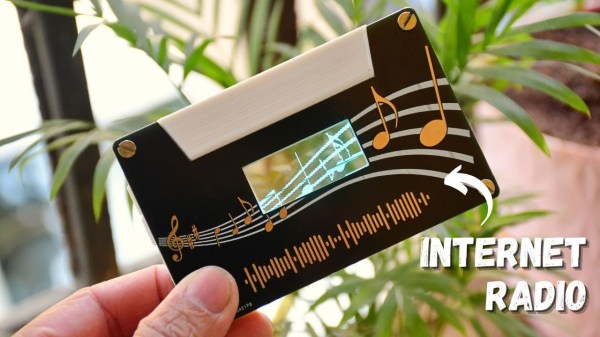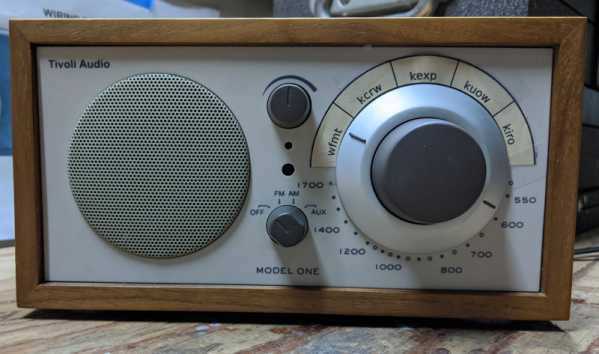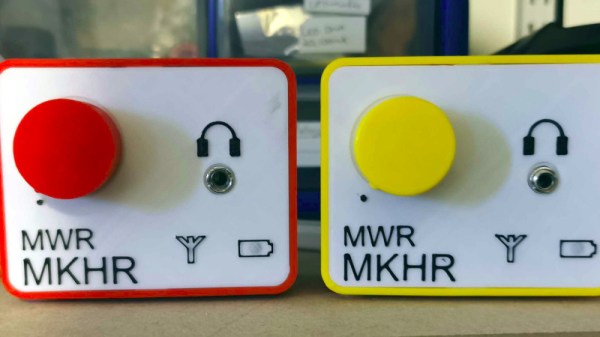The Functionalist design philosophy that Dieter Rams brought to Braun from the 50s to the 90s still inspires the look of a few devices, including Apple’s iPod, Teenage Engineer’s synthesizers and recorders – and [2dom]’s IR7 streaming radio.
The streaming radio was inspired by Braun’s portable radios, particularly the SK2, TP1, and the T3 pocket radio. [2dom] started with the T3’s circular pattern of holes and experimented with several variations, finally settling on a cylindrical shape with a central display; a prototype with a low-power monochrome rectangular display was eventually rejected in favor of a circular LCD. The housing consists of four 3D-printed components: an upper and lower shell, a resonator for the speaker, and a knob for a rotary encoder.
Electronics-wise, an ESP32 handles the computing requirements, while the LCD and rotary encoder provide a user interface. For audio, it uses a VS1053 MP3 decoder, PAM8403 amplifier, and a wideband speaker, with an audio isolation transformer to clean up the audio. To reduce power consumption, a MOSFET cuts power to the peripheral components whenever the device is in sleep mode. The full design is available on GitHub.
The end result of this effort is a quite authentic-looking 21st-century adaptation of Rams’s original designs. If you’re interested in more Braun designs, check out this replica of one of their desk fans. We’ve also seen a restoration of one of Braun’s larger radios, the TS2.
internet radio23 Articles
GlobeTune Will Widen Your Musical Horizons
Are you tired of the same old music, but can’t afford any new tunes, even if they’re on dead formats? Boy, do we know that feeling. Here’s what you do: build yourself a GlobeTune music player, and you’ll never want for new music again.
The idea is simple, really. Just turn what we assume is a nice, clicky knob, and after a bit of static (which is a great touch!), you get a new, random radio station from somewhere around the globe. [Alexis D.] originally built this as a way to listen to and discover new music while disconnecting from the digital world, and we think it’s a great idea.
[Alexis D.] has production in mind, so after a Raspberry Pi Zero W prototype, they set about redesigning it around the ESP32. The current status seems to be hardware complete, software forthcoming. [Alexis D.] says that a crowdfunding campaign is in the works, but that the project will be open-sourced once in an acceptable state. So stay tuned!
Speaking of dead-ish formats, here’s an Internet radio in a cassette form factor.
Internet Radio Built In Charming Cassette-Like Form Factor
You can listen to plenty of broadcast radio these days. There’s a lot of choice too, with stations on AM, FM, and digital broadcasts to boot. However, if you want the broadest possible choice, you want an internet radio. If that’s your bag, why not build a fun one like [indoorgeek’s] latest design?
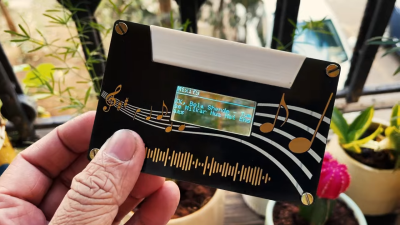 The build is based around a PCB and 3D-printed components that roughly ape the design of a cassette tape. It even replicates the typical center window of a cassette tape by using a transparent OLED screen, which displays the user interface. In a neat way, the graphics on the display are designed to line up with those on the PCB, which looks excellent.
The build is based around a PCB and 3D-printed components that roughly ape the design of a cassette tape. It even replicates the typical center window of a cassette tape by using a transparent OLED screen, which displays the user interface. In a neat way, the graphics on the display are designed to line up with those on the PCB, which looks excellent.
An ESP32 is the heart of the operation, which is responsible for streaming audio over the Internet via its WiFi connection. It’s powered by a small lithium-polymer battery, and hooked up with a MAX98357 Class D amplifier driven via the chip’s I2S hardware. Audio is played out over a small speaker salvaged from an old smartphone.
While it’s obviously possible to play whatever you like on a smartphone these days, sometimes it’s fun to have simple devices that just do a single job. Plus, we can’t deny this project looks really neat. Video after the break.
Continue reading “Internet Radio Built In Charming Cassette-Like Form Factor”
FLOSS Weekly Episode 768: Open Source Radio
This week Jonathan Bennett and Doc Searls talk with Tony Zeoli about Netmix and the Radio Station WordPress plugin. The story starts with the Netmix startup, one of the first places doing Internet music in the 1990s. That business did well enough to get bought out just before the Dot Com bubble burst in 2000. Today, Tony runs the Radio Station plugin, which is all about putting a station’s show schedule on a WordPress site.
In the process, the trio covers Internet radio history, the licensing complications around radio and streaming, the state of local radio, and more. Is there a long term future for radio? Does Creative Commons solve the licensing mess? Is AI going to start eating radio, too? All this and more!
Continue reading “FLOSS Weekly Episode 768: Open Source Radio”
Simple Internet Radio Transplant
While we have a definite sweet spot in our hearts for analog radio, there are times that just call for a digital upgrade. One of the downsides that can come with this upgrade is complexity. For example, the more software-minded among us might base their build on the Music Player Daemon, and use a web interface for control. But that’s not everyone’s idea of a good time, and particularly an older user of your gizmos might really appreciate a simple, tactile user interface. That’s the situation [Blake Hannaford] was in, while building an Internet powered radio for someone else.
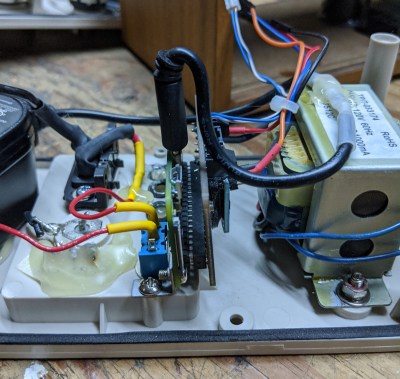 The solution was to take a familiar analog radio, the Tivoli Audio Model One, and give it a digital makeover. Now before you get worked up about wrecking the purity of a classic radio, note that the Model One is a faux-classic, made in 2000. No antiques were harmed in the making of this hack, and the exterior is essentially left stock — the only visible modification being the taped-on tuner label.
The solution was to take a familiar analog radio, the Tivoli Audio Model One, and give it a digital makeover. Now before you get worked up about wrecking the purity of a classic radio, note that the Model One is a faux-classic, made in 2000. No antiques were harmed in the making of this hack, and the exterior is essentially left stock — the only visible modification being the taped-on tuner label.
Inside it’s a Raspberry Pi Zero, the Adafruit Audio Bonnet, and a 3D printed bracket to tie a variable potentiometer to the tuning knob. The original volume knob and speaker are re-used. As [Blake] says, sometimes all you need is tuning and volume. Plus, re-using the speaker means that the whole unit still sounds great. Sometimes simple really is best.
While you’re here, check out our previous coverage of these style hacks and conversions!
A Simple Streaming Radio Receiver
For those interested in a career in broadcast radio there aren’t many routes into the business. Student radio, pirate radio, and hospital radio usually feature somewhere near the start of any DJ’s resumé. Hospital radio stations often don’t have a transmission license and have historically relied on wired systems, but since those can’t reach everywhere they are now more likely to look to the Internet. [AllanGallop] has created the Mini Web Radio for the hospital station in the British city of Milton Keynes, a compact battery-powered single station streaming radio receiver that can pick up those tunes anywhere with a wireless network connection.
Inside the neatly designed 3D printed box the hardware is quite straightforward, a WeMos ESP32 board and a MAX98357A I2S digital amplifier module all powered by an 18650 cell. There’s a volume control and headphone socket, which is all that’s needed for the user interface. The software has code for both Arduino and Platform.io and is configured as you might expect through a web interface. Everything can be found in a handy GitHub repository should you wish to build one yourself. Meanwhile, it’s particularly pleasing as a Hackaday scribe to feature a project with roots in one’s own hackerspace, in this case, Milton Keynes Makerspace.
Thanks [Cid] for the tip!
ESP32 Internet Radio Is No Game
More than once, we’ve looked at a cool board like the TTGO T-Display and thought, “What can we build with this?” If you’re [Danko Bertović], the answer is the tiny Internet radio you can see in the Volos Projects video below.
Of course, the core Internet streaming code would be useful with any ESP32, but the display makes for a good-looking unit. The code is available on GitHub. With judicious use of network and audio libraries, the player only takes a few hundred lines of code. Pretty impressive considering it even shows a visualization on the tiny display screen.
What we’d really like to see is a nice case, power supply, and speaker option to make a tiny and portable unit. With a 3D printer, it is easy to make very professional-looking projects, as we often see. On the other hand, it does look better than the breadboard version you can see towards the end of the video. It is, though, a neatly done breadboard.
If you want a larger screen, you might enjoy the ESP32 internet radio we looked at before. Probably our favorite case for an Internet radio was this globe.



